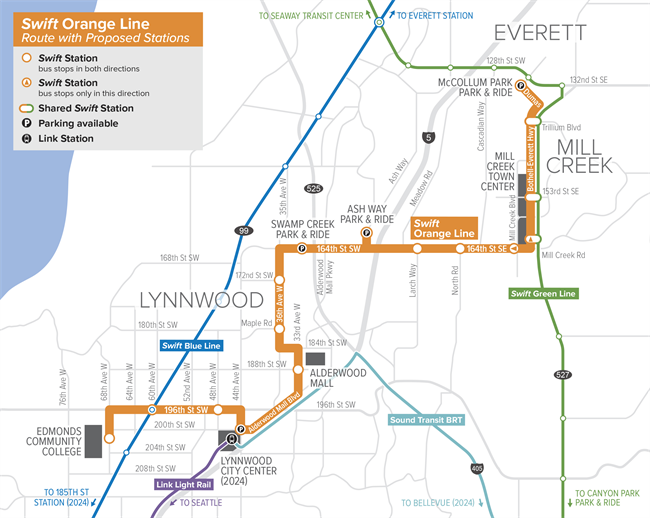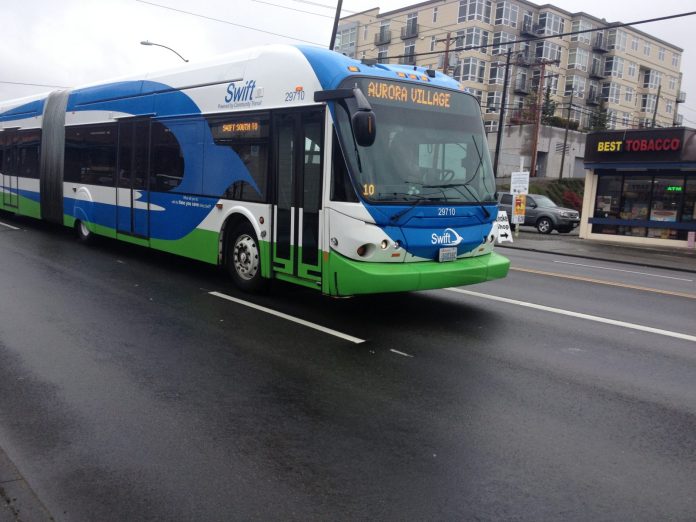Community Transit is beginning to tip its hat on things to come as light rail opening in Lynnwood approaches in 2024. Last week, the transit agency published its six-year transit development plan, which spans the same time period. The plan envisions expansion of the Swift bus rapid transit network, redeployment of commuter bus service hours into local service, and ridership growing from 10.6 million in 2018 to 14.4 million in 2024, a 36% increase.

In the next few years, Community Transit is looking to continue ramping up service levels and expand its bus fleet. By 2024, annual service hours will grow to 566,864, a 37% increase over 2018, while the bus fleet expands to 338 coaches, an 18% increase over 2018.

Annual service hour growth will be modest in 2020 through 2023 before taking big leap in 2024. This year, service hours already ballooned as the Swift Green Line began service in March and recent service changes went into effect. Fleet growth will follow similar trends to annual service hour growth through 2024.
Early concepts for service growth through 2024 are as follows:
- In March 2020, Community Transit will focus on way to improve overall service reliability and connections between routes. It is possible that the March service change could include additional trips on routes with high demand.
- In September 2020, Community Transit is considering a variety of service improvements. One set of changes would be to add more trips on in-demand routes that are worth investment to frequent, 15-minute service. Another set of changes would be restructuring routes on SR-527, SR-96, and Airport Road so that they better integrate and complement Swift Green Line service. Finally, new routes could be introduced in the southern part of Snohomish County where demand exists but no local bus service is provided.
- In 2021, Community Transit will shift priorities to begin restructure some cross-county bus service. Several commuter routes could be truncated at the Northgate Link light rail station opening that year. This is somewhat a turn of events as Community Transit has long said this was not a sensible choice given limited bus layover space and time competitiveness. But perhaps routinely and dramatically delayed buses in Downtown Seattle and University District has changed their tune. Another concept is to add more trips on in-demand routes that are worth investment to frequent, 15-minute service and expanding hourly service on other routes. Finally, new routes could be introduced in the southern part of Snohomish County where demand exists but no local bus service is provided.
- In the time period of 2022 through 2024, Community Transit will focus on network restructure of local bus routes (particularly on 164th St SW, 36th Ave W, and 196th St SW) and rolling out network enhancements to increase frequency, improve span of service, and provide better access in the northern and eastern parts of Snohomish County. One cited example of the latter is new service in Arlington on SR-531, though its no guarantee at this point. Community Transit will also focus on how to best restructure its commuter network so that service feeds into light rail stations opening in Lynnwood and Mountlake Terrace and expanding its Swift bus rapid transit network with the Blue and Orange Lines.
In 2024, light rail will be an integral part of Community Transit’s Snohomish County network and buses will no longer need to run deep across the county line. A priority for the transit agency is to expand the Swift bus rapid transit network. Two expansions of that network are planned with the rollout of the Swift Orange Line and extension of the Swift Blue Line.

The Swift Orange Line is planned to primarily run along 196th St SW and 164th St SW/SE to connect Edmonds Community College, Lynnwood City Center Station, Ash Way, Mill Creek Town Center, and McCollum Park. The line will operate on an 11.3-mile long corridor with 15 stops. Service hours to operate the line will be fairly consequential with 42,500 annual service hours dedicated to it, which accounts for virtually all new service hours in 2024.
Community Transit expects that project will top $85 million to realize with funding going toward planning, design, bus acquisition, transit priority improvements, and construction of stations. Funding has been tentatively identified as follows:
- $5 million from the Federal Transit Administration for project development under the 5307 grant program;
- $5 million from the Federal Transit Administration for station construction under the 5307 grant program;
- $42 million from the Federal Transit Administration for construction under the Small Starts grant program;
- $5 million from the Connecting Washington transportation program;
- $7 million for bus acquisition under the Congestion Mitigation and Air Quality grant program; and
- $22 million in local funding for the program generally.
The Swift Blue Line extension is fairly short at 1.8 miles. It will continue further south on SR-99 from its current terminus at Aurora Village to N 185th St and then proceeding along the street toward I-5 to reach new N 185 Street Link light rail station in Shoreline. Community Transit estimates that this extension will cost approximately $15 million and involve the construction of six new stops, transit priority improvements, and acquisition of five new Swift buses. The cost estimate assumes that $10 million will be made available through state grants and another $5 million in local funding.
To facilitate this kind of growth, the plan calls for increasing bus base capacity and adding new buses to the fleet. Community Transit is already undergoing a multi-year process to expand bus base capacity that is expected to cost about $70 million. The process will run through 2025 to allow for staffing capacity, maintenance, and storage.

Through 2024, Community Transit expects to replace 107 buses to maintain the fleet. Most of these will be 40-foot buses, but sizeable shares will also be in the 60-foot, double-decker, and Swift categories. Expansion of the fleet will include 13 40-foot buses and 21 Swift buses, an increase of 34 buses in total.
Stephen is a professional urban planner in Puget Sound with a passion for sustainable, livable, and diverse cities. He is especially interested in how policies, regulations, and programs can promote positive outcomes for communities. With stints in great cities like Bellingham and Cork, Stephen currently lives in Seattle. He primarily covers land use and transportation issues and has been with The Urbanist since 2014.



